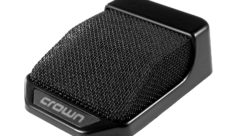
Telex S.A.F.E.-1000HD
Aug 1, 2004 12:00 PM,
By John McJunkin
Telex S.A.F.E.-1000HD and EV767a handheld mic
and transmitter
Corporate espionage is a relatively new term, but it’s very much a reality. High-tech spying, wiretapping, and “listening in” used to be techniques restricted to James Bond types or three-letter governmental agencies. Now a savvy agent with a scanner from Radio Shack can park outside your client’s headquarters and listen in on a meeting of the board or a confidential speech from a corporate partner. Or imagine explaining to a superior-court judge why an ambulance-chasing lawyer’s goon squad was able to record privileged conversations because of a lack of security in the wireless system you just installed. It is for those, among other reasons, that cabled microphones have traditionally appeared at the lectern, in lieu of the high-quality wireless mics that are available today.
Telex has a solution. Its S.A.F.E.-1000HD (Secure Audio Frequency Encryption) system enables encrypted transmissions that thwart the bad guys while allowing you to have high-quality wireless anywhere you need it. Whenever proprietary information is going to be presented through the wireless system, the signal is scrambled sufficiently to prevent espionage or stealing the signal.
PLAYING IT SAFE

EV PolarChoice Satellite transmitter
Telex’s S.A.F.E. system provides audio with 32-bit encryption over 900-plus possible channels with as many as 16 systems in simultaneous operation. The system is based upon technology developed by Telex for intercoms used by the NFL. It was certainly advantageous for one team to know what the other was up to by listening in, so Telex developed this encryption, and now it’s available to you. The S.A.F.E.-1000HD system that I reviewed included the S.A.F.E.-1000 UHF receiver, a S.A.F.E.-HD EV767a NDYM handheld transmitter (based upon the Electro-Voice 767a microphone) along with hardware, antennae, and a power supply. The receiver is a synthesized PLL type with two bands, the A from 680 to 704 MHz and B from 722 to 746 MHz. Channels are user-programmable in 25 kHz steps, yielding more than 900 channels. Diversity is achieved through Telex’s proprietary digital signal-processing Posi-Phase True Diversity circuitry. Both digital and amplitude squelching are available to help prevent false squelching. The receiver’s front panel presents simple operation with just four buttons: Menu, Set, Up, and Down. An LCD shows channel, diversity indication, RF strength of signal, and audio level. The receiver’s published frequency response is 100 Hz to 7 kHz at ±2dB, and the published signal-to-noise ratio is less than 90 dB. It’s a half-rack unit with hardware enabling the use of one or two in a single rackspace.
The handheld microphone is a cardioid EV 767a. The transmitter has an audio gain adjustment with a 26 dB range, enabling appropriate gain staging. The transmitter also features an LCD showing channel, group, frequency, and battery level. Additionally, there’s a red LED low-battery indicator. The antenna is a half-wave unit concealed within the microphone itself. This is a low-power transmitter with a range of output from 5 to 50 mW. Although the review unit featured the EV 767a dynamic microphone, an EV RE-510 condenser is also available. Telex has a body-pack transmitter available, as well, with a TA4M connector for use with a lavalier or headset microphone.
An EV PolarChoice PC-12 microphone was also included with the review kit. This gooseneck-mounted lectern-style microphone is 12 inches in length. The PC-18 and PC-5 are also available with lengths corresponding to their model numbers. EV additionally provides the PC Satellite wireless transmitter base, which is perfect. The transmitter fits neatly in the base of the gooseneck mic, enabling simple wireless usage for either boardroom or lectern. The mic is a back electret, dual-condenser microphone, which yields four different polar patterns: omnidirectional, cardioid, supercardioid, and hypercardioid patterns. The obvious use of the omnidirectional pattern would be in a board meeting scenario, picking up all voices in the entire boardroom. The three cardioid patterns would be used for a lectern speaker, and having three levels of pattern tightness is welcome when attempting to avoid feedback in a public-address situation. Considering its likely applications, this microphone is capable of handling plenty of sound pressure level (more than 135 dB, according to the manufacturer). Self-noise is reasonable at less than 26 dBA. Because this is an electret condenser, it requires phantom power, but it’s not picky, operating on 12 to 52 VDC, and it consumes less than 3 mA of current. The published frequency of the mic is 50 Hz to 20 kHz. Telex’s graphical response curve shows a gentle slope of about 6 dB per octave from 80 Hz up to about 500 Hz and then an even more gentle slope up to 7.5 kHz, with a peak at just over 3 dB. You’ll want to know about this peak when wringing monitors.
MIC TEST
After plugging the receiver in to my mixer, I popped the included 9V battery into the handheld microphone, turned it on, and immediately had signal. If I had multiple systems with which to work, setting up channels and groups would have been only a little less straightforward. The front panel of the receiver is disarmingly simple, even to the extent that it might cause a little confusion. Telex has attempted to simplify the operation by having as few controls as possible, and this requires a bit of menu diving. Luckily, it’s pretty intuitive. Until you get accustomed to it, however, you’ll probably want to have the manual handy. I would characterize it as analogous to having a modern delay with four push buttons on it when you’re accustomed to having a knob for each function. It’s nice to be able to immediately grab a knob knowing exactly what it does. Unfortunately, that is simply not practicable on a unit of this size. Even if it were a full rackspace in width, it would be difficult to have each function represented with a knob or switch.
The audio quality was great. There’s not a lot of low end, which, based upon the manufacturer’s specs, is no surprise. It’s nice and quiet, and the high end sounds good. The gooseneck mic had somewhat more low end (though nothing to write home about) but much better transient handling, as would be expected with a condenser mic. Both mics sound nice, though, and are more than adequate for voice/vocal applications.
FEELING SECURE
The big thing with this system for me is its plug-and-play aspect. It was easy to set up, and if you don’t mind a little menu diving, it’s great. Above all, the peace of mind of knowing that the audio is encrypted and only usable by you is the key feature here, and for many applications, that is very important. If you have any such needs, check out this system.
John McJunkinis the principal of Avalon Audio Services in Phoenix and engages in consulting for both studios and live sound applications.
PRODUCT SUMMARY
Company: Telex; www.telex.com Electro-Voice; www.electrovoice.com
Product: S.A.F.E.-1000HD
Pros: Very simple setup, good-quality audio. EV PolarChoice and EV 767a handheld mics have good sound.
Cons: Menu diving required due to front-panel restrictions. Not much low end.
Applications: Corporate boardrooms, courtrooms, or conference centers.
Price: $1,890
SPECIFICATIONS
RF
Frequency Range A band 680-704 MHz (TV channels 49, 50, 51, 52); B band 722-746 MHz (TV channels 56, 57, 58, 59)
Number of Channels 950 (programmable in 25 kHz steps)
Receiver Type Synthesized PLL agile UHF
Modulation Type NFSK
Squelch Digital plus amplitude
AUDIO
Frequency Response 100 Hz-7 kHz @ 2 dB
Encryption 32-bit (16 imbedded, 16 user assigned)
Audio Output Level Line level 8 mV-0.775 V RMS/100 kž load/balanced -10 dBV max
Distortion <1.0% (@1 kHz)
Signal-to-Noise Ratio >90 dB
Dynamic Range >90 dB
GENERAL
Power Supply External 12 VAC, 750 mA in-line
Size (H×W×D) 1.72″ × 7.50″ × 8.38″ 43.69 mm × 190.50 mm × 212.85 mm
Mic Elements EV N/D 767a dynamic, RE-510 condenser, or PolarChoice PC-5, -12, or -18 goosenecks









